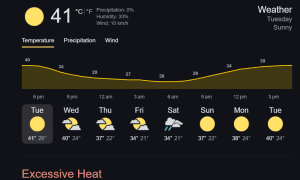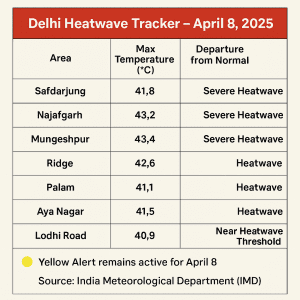New Delhi, April 8, 2025 — As Delhi continues to reel under severe heatwave conditions, the India Meteorological Department (IMD) has issued a “Yellow Alert” for the entire National Capital Region (NCR), urging residents to prepare for unrelenting high temperatures through April 8. According to the IMD, maximum temperatures are expected to hover between 40°C and 42°C, with localized areas potentially crossing even higher thresholds.
The alert comes as large parts of North and Central India experience a prolonged dry spell, causing significant heat stress and raising concerns over public health and infrastructure. While the scorching conditions are expected to persist for the next 48 hours, meteorologists predict a possible dip in mercury levels beginning April 9, due to a Western Disturbance anticipated to affect the northern belt.
This moderate shift in weather could offer temporary relief from the heat, but officials have cautioned that above-normal temperatures may return later in April, which historically marks the peak of pre-monsoon heatwaves in Delhi.
Current Temperature Status: Delhi’s Mercury Breaches 40°C as Heatwave Intensifies
Delhi is currently in the grip of a season-defining heatwave, with temperatures soaring past the critical 40°C threshold across multiple monitoring stations. The Ridge area emerged as the hottest zone, recording a sweltering 40.7°C on April 5, making it the highest temperature in the capital this year so far. Not far behind, regions such as Palam, Najafgarh, Pitampura, and Mungeshpur reported highs ranging from 39.5°C to 41.2°C, further validating the IMD’s heatwave warning.
According to the India Meteorological Department, these temperatures are significantly above the long-term climatological averages for early April, which typically range between 35°C and 37°C. The ongoing spike represents an anomaly of 4.5°C to 6°C above normal, thereby meeting the official threshold for heatwave classification in the plains.
A heatwave is declared when the maximum temperature crosses 40°C and remains at least 4.5°C above the region’s climatological average for two consecutive days. The IMD has confirmed that these conditions have been met in several pockets of Delhi, officially placing them under a localized heatwave alert for April 7 and 8.
Meteorological experts attribute this sustained heat pattern to a combination of atmospheric high-pressure systems, delayed Western Disturbances, and stagnant wind flow, which have blocked cooler air from entering the region. Additionally, minimal pre-monsoon rainfall and dry surface conditions have contributed to low humidity levels, further intensifying the dry heat and thermal discomfort.
The RealFeel® temperature, as measured by private forecasters like AccuWeather, has also climbed higher, with parts of the city experiencing perceived temperatures of 42–44°C during peak afternoon hours, making conditions dangerous, especially for vulnerable populations like children, the elderly, and outdoor laborers.
While heatwave conditions are expected to persist until at least April 8, the IMD suggests modest relief may arrive after April 9. A fresh Western Disturbance approaching the Western Himalayan Region may induce changes in wind direction, promote cloud formation, and cause a slight dip in day and night temperatures over the capital and adjoining regions.
April 8, 2025 Update:
 On April 8, 2025, several weather stations across Delhi recorded soaring temperatures yet again, with the Safdarjung observatory—considered the city’s official benchmark—logging a high of 41.8°C, while Najafgarh and Mungeshpur crossed 43°C, marking one of the hottest days of the season so far. According to the IMD, the temperature was 5.1°C above the normal average, qualifying as a severe heatwave in isolated pockets. The “Yellow Alert” remains in force, as health authorities reiterated warnings to avoid outdoor exposure during peak hours.
On April 8, 2025, several weather stations across Delhi recorded soaring temperatures yet again, with the Safdarjung observatory—considered the city’s official benchmark—logging a high of 41.8°C, while Najafgarh and Mungeshpur crossed 43°C, marking one of the hottest days of the season so far. According to the IMD, the temperature was 5.1°C above the normal average, qualifying as a severe heatwave in isolated pockets. The “Yellow Alert” remains in force, as health authorities reiterated warnings to avoid outdoor exposure during peak hours.
Relief on the Way: IMD Forecasts Temporary Break from Heatwave After April 8
In a glimmer of relief for residents of Delhi and adjoining areas, the India Meteorological Department (IMD) has indicated that heatwave conditions may subside starting April 9, as a fresh Western Disturbance is set to influence the Western Himalayan Region beginning April 8. The system is expected to alter upper-level wind patterns, inject moisture into the atmosphere, and bring partial cloud cover—factors that typically help to reduce surface temperatures in the northern plains.
According to the IMD’s daily heatwave bulletin, this change in the synoptic weather system could lead to a moderate drop of 2°C to 3°C in maximum temperatures over the National Capital Region (NCR), easing daytime discomfort and bringing temporary relief to millions exposed to sweltering conditions.
“Heatwave conditions will persist in isolated pockets of Delhi till April 8. From April 9 onward, we expect a slight drop in day temperatures and a gradual abatement of the heatwave,” said an IMD spokesperson during a morning press briefing held at the Meteorological Centre, New Delhi.
The Western Disturbance, currently forming over parts of Iran and Afghanistan, is projected to move eastward and impact the Western Himalayas, including Jammu & Kashmir, Himachal Pradesh, and Uttarakhand, by late April 8 or early April 9. Though it is unlikely to bring widespread rainfall to Delhi itself, cooler winds descending from the hills, along with increased cloudiness, may help in lowering surface radiation and reducing the heatwave’s intensity.
IMD officials have also noted that pre-monsoon thunderstorms or dust storms cannot be entirely ruled out in parts of northwest India by mid-April, which may further influence local weather conditions.
However, the department has cautioned that any relief will likely be short-lived, as above-normal temperatures are forecast to return later in April, especially if no significant precipitation is recorded. Citizens have been advised to continue hydration, avoid outdoor exposure during peak hours (12–4 PM), and check for health advisories, particularly for children, the elderly, and those with pre-existing conditions.
Delhi Heatwave Tracker – April 8, 2025:


| 📍 Area | 🌞 Max Temperature (°C) | 🔺 Departure from Normal | 🌡️ Heatwave Status |
|---|---|---|---|
| Safdarjung | 41.8°C | +5.1°C | Severe Heatwave |
| Najafgarh | 43.2°C | +6.0°C | Severe Heatwave |
| Mungeshpur | 43.4°C | +6.2°C | Severe Heatwave |
| Ridge | 42.6°C | +5.3°C | Heatwave |
| Palam | 42.1°C | +4.9°C | Heatwave |
| Aya Nagar | 41.5°C | +4.7°C | Marginal Heatwave |
| Lodhi Road | 40.9°C | +4.5°C | Near Heatwave Threshold |
Health Advisory and Precautionary Measures: Authorities Urge Caution as Heat-Related Illnesses Rise
With Delhi experiencing persistent heatwave conditions and the mercury hovering around dangerous levels, the India Meteorological Department (IMD) and Delhi Health Department have jointly issued a public health advisory, warning residents about the heightened risk of heat-related illnesses, including heat exhaustion, dehydration, sunburn, and heatstroke.
Health officials have strongly recommended that citizens take the following precautions to minimize exposure and avoid health emergencies:
-
💧 Stay well-hydrated by drinking water at regular intervals—even if you are not feeling thirsty.
-
☀️ Avoid direct exposure to sunlight, especially during peak hours between 12 PM and 4 PM.
-
👕 Wear light-colored, breathable cotton clothing and cover your head with caps, scarves, or umbrellas when stepping out.
-
🧃 Consume Oral Rehydration Solutions (ORS), lemon-salt water, or electrolyte drinks to maintain fluid balance and prevent dehydration.
-
👵 Check on vulnerable individuals such as the elderly, infants, outdoor workers, and people with chronic illnesses, as they are more susceptible to heat-related complications.
-
🧊 Cool off with frequent showers, wet cloths, or cold compresses to regulate body temperature.
🚑 Hospitals across Delhi, including Safdarjung, LNJP, and AIIMS, have reported an uptick in heatstroke and dehydration cases in recent days. Emergency rooms are seeing more patients with symptoms such as dizziness, fainting, elevated body temperature, muscle cramps, and confusion—classic signs of heat exhaustion or heatstroke.
In response, the Delhi government has ramped up public awareness campaigns through digital screens at metro stations, government buildings, schools, and local transport hubs. Posters, pamphlets, and public service announcements are also being circulated to ensure that residents are fully informed about preventive steps.
Special advisories have been issued for school-going children and outdoor laborers, suggesting the rescheduling of outdoor activities to early mornings or evenings and providing shaded rest zones and drinking water facilities at construction sites and bus stands.
Authorities have also urged citizens to dial 102 or contact emergency medical services immediately if symptoms of heatstroke—such as confusion, high fever, or unconsciousness—are observed in themselves or others.
Impact on Daily Life and Power Demand: Delhi’s Infrastructure Under Stress Amid Scorching Heat
As the unrelenting heatwave continues to grip the National Capital Region, its ripple effects are being acutely felt in daily life—particularly in terms of electricity consumption, water supply, and public services.
According to officials from Delhi Power Distribution Companies (Discoms), the city has recorded one of the highest seasonal electricity demands in recent years, largely driven by a spike in air conditioning, coolers, and fan usage across residential and commercial sectors. On April 6, Delhi’s peak power demand soared past 7,000 MW, putting immense pressure on transformers and distribution networks.
“We are witnessing peak load conditions, especially during late afternoons and evenings. Our teams are monitoring the grid 24/7 to prevent localized outages,” said a senior official from BSES Yamuna Power Limited.
🛑 Water scarcity concerns have also resurfaced, with demand reaching its peak due to increased household consumption and heightened usage in public places. The Delhi Jal Board (DJB) reported distribution delays and low pressure in several colonies of South, East, and Outer Delhi, prompting the deployment of additional water tankers to affected areas.
Meanwhile, several localities have reported intermittent power outages, especially during high-consumption hours, sparking frustration among residents in Lajpat Nagar, Mayur Vihar, and Mehrauli, who complained of frequent voltage drops and disrupted schedules.
🏫 Educational institutions have responded to the crisis by curtailing outdoor activities, rescheduling physical education classes, and urging students to carry extra water and wear sun protection. Some schools have even implemented half-day sessions for junior classes to safeguard children from exposure.
🏢 On the administrative front, multiple government departments—including the Disaster Management Authority, Delhi Health Department, and Municipal Corporations—have activated emergency heatwave response protocols, which include ensuring uninterrupted water and electricity supply, setting up medical kiosks at key transit points, and providing special assistance to slum dwellers and construction workers.
In markets, parks, metro stations, and public squares, the sight of exhausted citizens seeking shade, portable fans, and electrolyte drinks has become increasingly common.
Unless relief sets in by April 9 as predicted by the IMD, the strain on infrastructure and public well-being may continue to mount, urging urgent preparedness and sustainable cooling strategies in urban planning.
Conclusion: Mild Relief Ahead, But the Heat Battle Isn’t Over
While the India Meteorological Department (IMD) anticipates a modest dip in temperatures after April 9, experts warn that this should not be mistaken for the end of summer distress. April and May remain the peak summer months in North India, and with climate variability and dry winds in play, recurring heatwave spells remain a very real possibility.
Citizens are urged to stay vigilant and follow heatwave advisories issued by local authorities. Special attention should be given to the elderly, young children, and outdoor workers, who are especially vulnerable during such extreme weather conditions.
“Heatwave conditions are not just about discomfort—they pose serious public health and infrastructure challenges. Preparedness is key,” said a senior IMD official.
The IMD will continue to monitor weather patterns closely and provide timely updates through its official platforms. For real-time alerts and weather bulletins, citizens can visit the IMD official website.
As the capital braces for the long summer ahead, authorities and residents alike must prioritize climate resilience, community awareness, and precautionary action to stay safe.
For more real time updates, visit Channel 6 Network.

